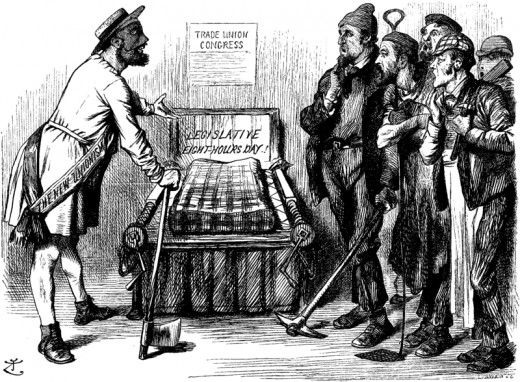Never Cut-and-Paste a Bible Verse

Force Fitting Bible Verses Into Inaccurate Translations
Whenever I’m studying the Scriptures or writing hubs for that matter, I use this simple rule—Never cut-and-paste Bible a verse—to help me and my readers interact with the author’s intended message in any scriptural passage. It’s an amazingly effective technique that I’d like to share with you as well.
I read the paragraph, not just the verse. I take note of the context by reading what is written before and after the verse in question. Since the context frames the verse and gives its specific meaning, it helps me to understand and answer the question, “What is the author saying?”
A Strange Bedfellow To Avoid
In Greek mythology, Procrustes, whose name means “he who stretches,” was a villainous son of Poseidon. He was a monstrous bandit from Attica, who made life miserable for travelers along the mountain road from Troezen to Athens. He kept an inn along the side of the road in which there was an unusual bedchamber with a very special iron bed. He would offer his hospitality to these travelers by providing them a pleasant meal and a night’s rest in his special bed. If the guest asked what was so special about it, Procrustes replied, "Why, it has the amazing property that its length exactly matches whomsoever lies upon it."
What Procrustes didn't volunteer, was the method by which this "one-size-fits-all" bed was achieved. As soon as the guest lay down, Procrustes would shackle their bodies to the bed frame. If they were too short for the bed, he attached ropes to their ankles and stretched them until their bones cracked. If they were too long for the bed, Procrustes chopped off their feet or lopped off their heads. In this way, everyone was made identical in size. The victim was ultimately ‘force fitted’ onto the infamous bed frame.
Similarly, biblical scholars, students, laypeople, and even well meaning hubbers alike, have sought to force fit the Scriptures upon the bed of their brand of theology. By ignoring the context and isolating the verse(s), we do violence to the bibilical truth. If we neglect the context, the result of our study or written hub subjects the Scriptures to a cut-and-paste up job of ideas, illustrations, and interpretations of others as well as our own. If we fail to exercise due diligence in our study of the Word, we will unwittingly hold the Scriptures hostage as we unintentionally shackle, squeeze, stretch or sever the text to fit into a Procrustean Bible study of sorts. The fruit of our finding will only result in an inaccurate amputated interpretation served on a misleading cut-and-paste biblical bed.
A Simple Rule To Adapt
Here’s how to use the simple rule, Never cut-and-paste a Bible verse. In its original form, the Bible was never written with chapter or verse numbers. These are modern day tools that help us easily locate the chapter and verse. When you come across a verse in your reading or study, try to catch “the big picture” by looking at the larger unit or context that it’s anchored to. Then begin to narrow your focus. It’s not a difficult or time-consuming study discipline. Take a brief moment to read the verse in its wider context.
With the verse before you, have the broad context of the book in the back of your mindset. What type of literature is it? Are we dealing with history, poetry, or narrative? Different literary forms require specific approaches. What was the author’s intended meaning in the passage? What idea was he trying to develop and communicate? Who was his audience? What the life setting or cultural background at the time this writing?
It pays to stand back from the verse and seek out natural breaks in the text in order to identify major units of thought. Ask yourself, “What does this paragraph or group of paragraphs tell me about the verse in question?”
Why is this little exercise important? Words have different meanings in different contexts. If we isolate the verse, one meaning may surface. But how can we determine if it’s the right one? Reaching out for the nearest dictionary won’t do. Dictionaries only complicate the issue, giving us a wide range of choices. This can get confusing. Fret not friend, help is not far away, but just around the corner. It comes to us in the form of the surrounding paragraph.
With the larger context before us, you are free to narrow your focus, observing and/or interpreting the meaning of the verse itself. Summing up the passage in your own words, based on your findings, is a key element to your study. This includes your careful observation, research and study of the verse in its context. By paraphrasing the passage, you will discover if your interpretation is running parallel to the overall context or found contrary to the author’s intention.
Here’s how it works. Just replace the passage in question with your own words or paraphrase. Does the passage still make sense in light of the larger context? Is it still in sync with the bigger picture? Does it flow naturally?
This technique will immediately release interpretations that may be mercilessly shackled, squeezed, stretched or severed in a Procrustean Bible bed. Be mindful that an interpretation is your ability to say essentially the same thing as the author, but in your own words.
Please notice that I didn’t say, “Never quote a Bible verse.” I said, “cut-and-paste.” Just beware of simply reading the verse expecting to get an accurate meaning in isolation from the rest of the passage.
This simple rule just happens to be one technique drawn from the method of Inductive Bible Study—a subject that we will continue to explore in future hubs.
Copyright 2009, Gicky Soriano. All rights reserved.

Recommended Reading






